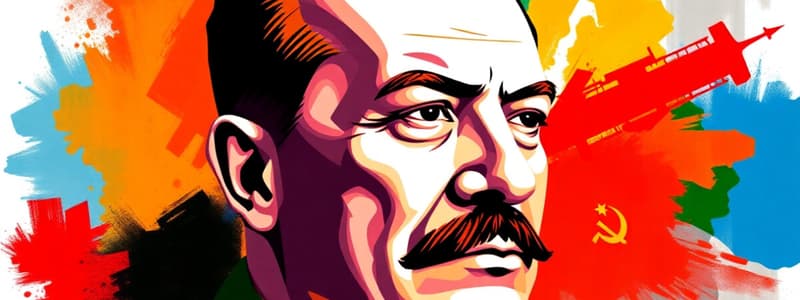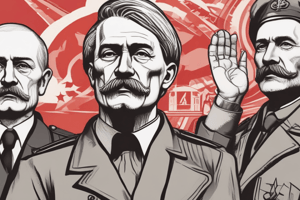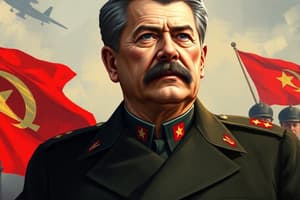Podcast
Questions and Answers
What event, occurring in November 1932, is considered a potential catalyst for Stalin's actions leading to the Great Purge?
What event, occurring in November 1932, is considered a potential catalyst for Stalin's actions leading to the Great Purge?
- The re-election of Nikolai Bukharin to the Central Committee.
- His wife's suicide and the criticisms of his policies contained in her note. (correct)
- A major economic boom that exacerbated existing wealth disparities.
- The public outcry over the forced collectivization of agriculture.
What was the main argument presented in the 'Ryutin Platform' that directly threatened Stalin's leadership?
What was the main argument presented in the 'Ryutin Platform' that directly threatened Stalin's leadership?
- An endorsement of Stalin's policies, but a suggestion that he delegate more authority.
- A detailed plan for agricultural reform.
- An appeal to the Central Committee urging Stalin's removal from power. (correct)
- A proposal to increase industrial output by 300% in five years.
How did Stalin utilize the assassination of Kirov to consolidate his power and justify the escalation of purges?
How did Stalin utilize the assassination of Kirov to consolidate his power and justify the escalation of purges?
- By directly blaming Trotskyite conspirators and using it as a pretext for widespread arrests and executions. (correct)
- By immediately opening an investigation led by independent observers to ensure transparency.
- By acknowledging the security failures and taking personal responsibility for not preventing the assassination.
- By implementing reforms aimed at reducing the power of the NKVD, thereby preventing future abuses.
Which of the following best describes the immediate consequence of the decree published after Kirov's assassination?
Which of the following best describes the immediate consequence of the decree published after Kirov's assassination?
What role did Kaganovich play in Stalin's rise to power and the implementation of his policies?
What role did Kaganovich play in Stalin's rise to power and the implementation of his policies?
What was the significance of the abolition of the title 'General Secretary' at the 17th Party Congress?
What was the significance of the abolition of the title 'General Secretary' at the 17th Party Congress?
Which of the following is true regarding Molotov's role in Soviet foreign policy during Stalin's rule?
Which of the following is true regarding Molotov's role in Soviet foreign policy during Stalin's rule?
What was the common motivation behind the workers' strikes in 1932?
What was the common motivation behind the workers' strikes in 1932?
What was the primary reason Stalin initiated a general purge of the Party in April 1933?
What was the primary reason Stalin initiated a general purge of the Party in April 1933?
Leonid Nikolayev's motives for assassinating Kirov were complex. Which of the following contributed to his actions?
Leonid Nikolayev's motives for assassinating Kirov were complex. Which of the following contributed to his actions?
What distinguishes the group led by Martemyan Ryutin from the 'old Bolsheviks' group led by Leonid Smirnov in their opposition to Stalin?
What distinguishes the group led by Martemyan Ryutin from the 'old Bolsheviks' group led by Leonid Smirnov in their opposition to Stalin?
How did Stalin portray Kirov's assassination to justify the subsequent purges?
How did Stalin portray Kirov's assassination to justify the subsequent purges?
What action taken against some NKVD men implies a potential cover-up or complicity in Kirov's murder?
What action taken against some NKVD men implies a potential cover-up or complicity in Kirov's murder?
How did Stalin react to the emergence of opposition groups within the Party elite during the crisis of 1932?
How did Stalin react to the emergence of opposition groups within the Party elite during the crisis of 1932?
What does the text imply about Stalin's position within the Politburo prior to the Kirov affair?
What does the text imply about Stalin's position within the Politburo prior to the Kirov affair?
Flashcards
The Crisis of 1932
The Crisis of 1932
A period of widespread famine in the countryside and worker strikes in industrial towns driven by economic factors and criticisms of Stalin's policies in 1932
Smirnov Group
Smirnov Group
An informal group of 'old Bolsheviks' who debated Stalin's removal, quickly arrested by the OGPU in 1932
Ryutin Platform
Ryutin Platform
A platform led by Martemyan Ryutin criticizing Stalin's policies and personality in 1932
Who was Sergei Kirov?
Who was Sergei Kirov?
Leningrad Party Secretary. He was seen as a popular figure within the party.
Signup and view all the flashcards
Purge of 1933
Purge of 1933
A general purge of the Party announced by Stalin in April 1933, targeting those branded 'Ryutinites'
Signup and view all the flashcards
17th Party Congress
17th Party Congress
Stalin received 150 negative votes. A split may have opened between those who wanted to maintain industrialization pace and those who wanted a more moderate approach.
Signup and view all the flashcards
Abolishment of 'General Secretary'
Abolishment of 'General Secretary'
The ending of a title previously held by Stalin due to the economic crises to delegate responsibility.
Signup and view all the flashcards
Who was Kaganovich?
Who was Kaganovich?
Responsible for Party patronage and helped Stalin defeat his political rivals.
Signup and view all the flashcards
Who was Molotov?
Who was Molotov?
Supported Stalin in the leadership struggle. He negotiated the Nazi-Soviet Pact.
Signup and view all the flashcards
Yagoda's Role
Yagoda's Role
Head of the NKVD, given powers to arrest and execute anyone found guilty of terrorist plotting after Kirov's murder
Signup and view all the flashcards
Decree Post-Kirov
Decree Post-Kirov
A decree published after Kirov's murder, granting the NKVD broad powers to arrest and execute anyone found guilty of terrorist plotting
Signup and view all the flashcards
Who was Leonid Nikolayev?
Who was Leonid Nikolayev?
Kirov's murderer.
Signup and view all the flashcards
Who was Kirov?
Who was Kirov?
A supporter of Stalin who was murdered in December 1934 under suspicious circumstances.
Signup and view all the flashcards
NKVD Complicity
NKVD Complicity
NKVD knew' all about the murder. Kirov's bodyguard and some NKVD men were 'known' all about the murder.
Signup and view all the flashcards
Trotskyite Conspiracy
Trotskyite Conspiracy
Accusations of a Trotskyite conspiracy, led by 'Zinovievites', to overthrow the Party, following Kirov's murder
Signup and view all the flashcardsStudy Notes
- In 1932, axes, saws, and hammers were used in freezing temperatures, resulting in 25,000 deaths out of 100,000 prisoners who were employed for this task.
- Stalin opened a shipping canal in 1933 with publicity, but at 12 feet deep, it was useless for bigger ships.
The Crisis of 1932
- In November 1932, Stalin's wife, Nadezhda, committed suicide after leaving a note criticizing Stalin's policies and sympathizing with his political enemies.
- Orlando Figes says this event "unhinged" Stalin, leading him to believe that even close allies could betray him.
- The reported cause of Nadezhda's suicide was appendicitis.
- There were worker strikes in industrial towns in 1932, driven by economic factors and criticisms of Stalin's leadership.
- Nikolai Bukharin, Stalin's old opponent, was re-elected to the Central Committee in June 1930.
- Some of those who formally backed Stalin against Bukharin were expelled for criticizing collectivization.
- Two opposition groups emerged within the Party elite in 1932.
- An informal group of old Bolsheviks, including Leonid Smirnov, was discovered holding meetings to discuss Stalin's removal and were arrested by the OGPU, Smirnov was expelled from the Party.
- Martemyan Ryutin led another group. Ryutin was a former Moscow Party Secretary and a 'rightist'.
- Their criticisms were known as the 'Ryutin Platform', they sent signed 'appeals' urging for Stalin's removal.
- Ryutin and his circle were arrested, and Stalin wanted their execution, but the Politburo overruled him, specifically Sergei Kirov.
- Twenty-four members were expelled from the Party and exiled from Moscow, due to the Ryutin affair.
- "Old Bolsheviks", including Zinoviev and Kamenev, were also expelled simply for knowing about the group without reporting it to the police.
- Ryutin was sentenced to ten years in prison.
- Ryutin was shot in 1937 on Stalin's orders.
- In April 1933, Stalin announced a general purge of the Party, branding over 18% of the Party membership as 'Ryutinites' over the next two years.
- Many purged members were new Party members whose loyalty Stalin felt unsure of and considered them 'careerists'.
The Kirov Affair, 1934
- In elections to the Central Committee, Stalin received about 150 negative votes (only three were officially recorded).
- A split emerged between those wanting to maintain industrialization and those wanting to stop grain seizures and increase workers' rations.
- Kirov spoke about stopping grain seizures and increasing workers' rations.
- Only Vyacheslav Molotov and Lazar Kaganovich of the Politburo firmly supported Stalin.
- At the 17th Party Congress, the title of 'General Secretary' was considered for abolishment.
- Stalin, Kirov, Zhdanov, and Kaganovich all had the title 'Secretary of Equal Rank'.
Key People
- Lazar Moiseyevich Kaganovich (1893-1991) had been a Bolshevik since 1911.
- From 1924, he was responsible for patronage and helped Stalin defeat his rivals.
- By 1930, he was a full member of the Politburo.
- He supported collectivization and brought the Moscow regional Party under Stalin's control (1930-35).
- Vyacheslav Mikhailovich Molotov (1890-1986) joined the Bolsheviks in 1906 and became secretary of the Central Committee in 1921.
- Molotov supported Stalin and was promoted to the Politburo in 1926.
- He purged anti-Stalin members in the Moscow Party Committee in 1928-30.
- He was chairman of the Council of People's Commissars until 1941.
- Molotov replaced Litvinov as the Soviet Commissar of Foreign Affairs in May 1939 and negotiated the Nazi-Soviet Pact in August.
Kirov's Murder
- Kirov was murdered in December 1934, under suspicious circumstances.
- Stalin was quick to claim the murder was part of a Trotskyite conspiracy led by Zinovievites to overthrow the Party.
- A decree was published a day after the assassination, granting Yagoda, head of the NKVD, the power to arrest and execute anyone found guilty of 'terrorist plotting'.
- About 6500 people were arrested in December under this law.
- Kirov was shot in the neck by Leonid Nikolayev in the Leningrad Party headquarters on December 1, 1934.
- Nikolayev was a disgruntled Party member who was once expelled, but reinstated.
- He suggested the NKVD knew about the murder, when questioned.
- Kirov's bodyguard and some NKVD men were killed in a car accident.
- Other NKVD men were sentenced for failure to protect Kirov.
Studying That Suits You
Use AI to generate personalized quizzes and flashcards to suit your learning preferences.




